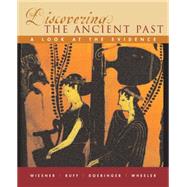
Note: Supplemental materials are not guaranteed with Rental or Used book purchases.
Purchase Benefits
What is included with this book?
| PREFACE | xi | ||||
| CHAPTER ONE The Need for Water in Ancient Societies | 1 | (20) | |||
|
1 | (4) | |||
|
5 | (3) | |||
|
8 | (9) | |||
|
|||||
|
17 | (2) | |||
|
19 | (2) | |||
| CHAPTER TWO Writing and Power: Defining World-Views (1750-200 B.C.E.) | 21 | (24) | |||
|
21 | (5) | |||
|
26 | (2) | |||
|
28 | (13) | |||
|
|||||
|
41 | (2) | |||
|
43 | (2) | |||
| CHAPTER THREE Polytheism and Monotheism in the Fertile Crescent, ca 3000-500 B.C.E. | 45 | (36) | |||
|
45 | (6) | |||
|
51 | (9) | |||
|
60 | (18) | |||
|
|||||
|
78 | (1) | |||
|
79 | (2) | |||
| CHAPTER FOUR Representing the Human Form (2600 B.C.E.-600 C.E.) | 81 | (24) | |||
|
81 | (6) | |||
|
87 | (3) | |||
|
90 | (12) | |||
|
|||||
|
102 | (1) | |||
|
102 | (3) | |||
| CHAPTER FIVE The Ideal and the Reality of Classical Athens | 105 | (24) | |||
|
105 | (2) | |||
|
107 | (3) | |||
|
110 | (16) | |||
|
|||||
|
126 | (1) | |||
|
127 | (2) | |||
| CHAPTER SIX The Equine Revolution (3700 B.C.E.-100 C.E.) | 129 | (29) | |||
|
129 | (4) | |||
|
133 | (3) | |||
|
136 | (18) | |||
|
|||||
|
154 | (2) | |||
|
156 | (2) | |||
| CHAPTER SEVEN The Achievements of Augustus | 158 | (23) | |||
|
158 | (2) | |||
|
160 | (5) | |||
|
165 | (13) | |||
|
|||||
|
178 | (1) | |||
|
179 | (2) | |||
| CHAPTER EIGHT The Development of Orthodoxy in Early Christianity | 181 | (21) | |||
|
181 | (3) | |||
|
184 | (5) | |||
|
189 | (10) | |||
|
|||||
|
199 | (1) | |||
|
200 | (2) | |||
| CHAPTER NINE Philosophy and Faith: The Problem of Ancient Suicide | 202 | (32) | |||
|
202 | (5) | |||
|
207 | (8) | |||
|
215 | (16) | |||
|
|||||
|
231 | (1) | |||
|
232 | (2) | |||
| CHAPTER TEN Slave Law in Roman and Germanic Society | 234 | (28) | |||
|
234 | (1) | |||
|
235 | (7) | |||
|
242 | (16) | |||
|
|||||
|
258 | (1) | |||
|
259 | (3) | |||
| CHAPTER ELEVEN The Transformation of Christianity | 262 | ||||
|
262 | (1) | |||
|
263 | (4) | |||
|
267 | (15) | |||
|
|||||
|
282 | (1) | |||
|
283 |
The New copy of this book will include any supplemental materials advertised. Please check the title of the book to determine if it should include any access cards, study guides, lab manuals, CDs, etc.
The Used, Rental and eBook copies of this book are not guaranteed to include any supplemental materials. Typically, only the book itself is included. This is true even if the title states it includes any access cards, study guides, lab manuals, CDs, etc.